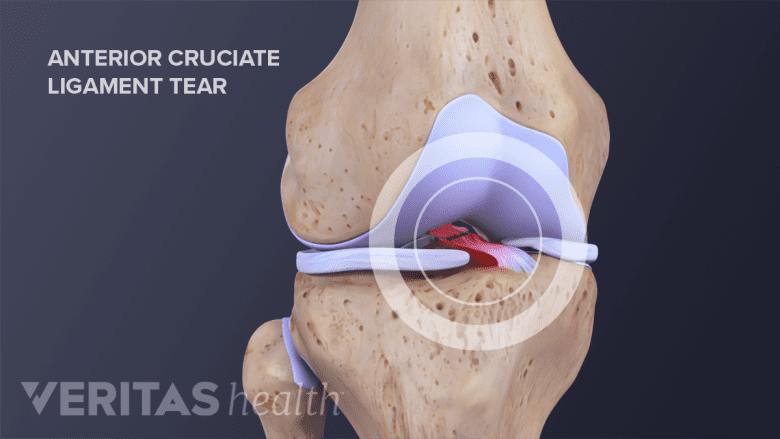The anterior cruciate ligament (ACL) is one of the main stabilizing ligaments of the knee, and when it is injured the knee may feel as if it will buckle and give out. Tears or ruptures of the ACL occur frequently in sports:
- As a result of cutting, pivoting, or single-leg landing
- Through a twisting force applied to the knee when the foot is planted on the ground or when landing on one foot
- From a direct trauma to the knee, usually the outside of the knee, as may occur in many contact sports, such as soccer and football
A complete tear of the ACL is also known as an ACL rupture.
In This Article:
- Anterior Cruciate Ligament (ACL) Tears
- ACL Tear Symptoms
- ACL Tear: Causes and Risk Factors
- ACL Tear Diagnosis
- ACL Tear Treatment Options
- ACL Tear Surgical Repair
Women and girls are most susceptible to ACL injury.
Injury to the ACL is painful and most individuals report a “pop” in their knee, followed by a feeling of instability. This feeling hinders athletic activities as well as simple daily activities such as walking down stairs. Surgery may be recommended to restore knee function, but is not always necessary.
What Is the ACL?
The anterior cruciate ligament runs diagonally and connects the thigh bone to the leg bone.
Ligaments are strong fibrous bands that connect bones to other bones. In the knee, the ACL is one of the 4 main ligaments that connect the femur (thigh bone) to the tibia (shin bone).
See Guide to Knee Joint Anatomy
The ACL attaches to the knee at the bottom, back of the femur (thigh bone) and crosses diagonally through the knee joint to attach at the upper part of the tibia (shin bone).
The posterior cruciate ligament crosses the knee joint in the opposite direction, making an “X” shape (cruciate is from the Latin word for cross). The ACL and PCL work together to stabilize the knee joint, especially during movement that involves sudden change of motion or impact.
The other two main knee ligaments, called the medial collateral ligament (MCL) and lateral collateral ligament (LCL), are located on either side of the knee and help prevent side-to-side movement.
The ACL Injury Grading System
An ACL injury may be diagnosed when the ligament is overstretched or torn. The tear may be partial or complete; a complete tear of the ACL is also known as an ACL rupture.
- Grade I tears refer to a slightly stretched ACL. Symptoms are typically mild. The ligament can still keep the knee stable.
- Grade II tears refer to stretching of the ACL to the point of looseness. These injuries are often referred to as “partial” tears. Symptoms are more severe than Grade I tears. Range of motion may be restricted and the knee may occasionally feel unstable (the knee feels like it is “giving out”).1Temponi EF, de Carvalho Júnior LH, Sonnery-Cottet B, Chambat P. Partial tearing of the anterior cruciate ligament: diagnosis and treatment. Rev Bras Ortop. 2015;50(1):9-15. Published 2015 Feb 14. doi:10.1016/j.rboe.2015.02.003
- Grade III tears (ligament rupture) are complete tears (the ACL has been split in two). Grade III tears may also be referred to as an ACL rupture. A person may not be able to bear weight on the injured leg.
ACL tears can produce a range of symptoms, which can make it difficult to diagnose without further examination from a doctor.
- 1 Temponi EF, de Carvalho Júnior LH, Sonnery-Cottet B, Chambat P. Partial tearing of the anterior cruciate ligament: diagnosis and treatment. Rev Bras Ortop. 2015;50(1):9-15. Published 2015 Feb 14. doi:10.1016/j.rboe.2015.02.003








